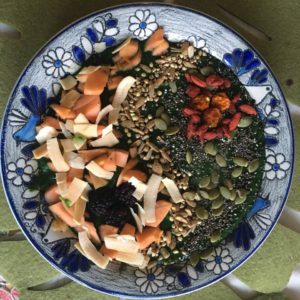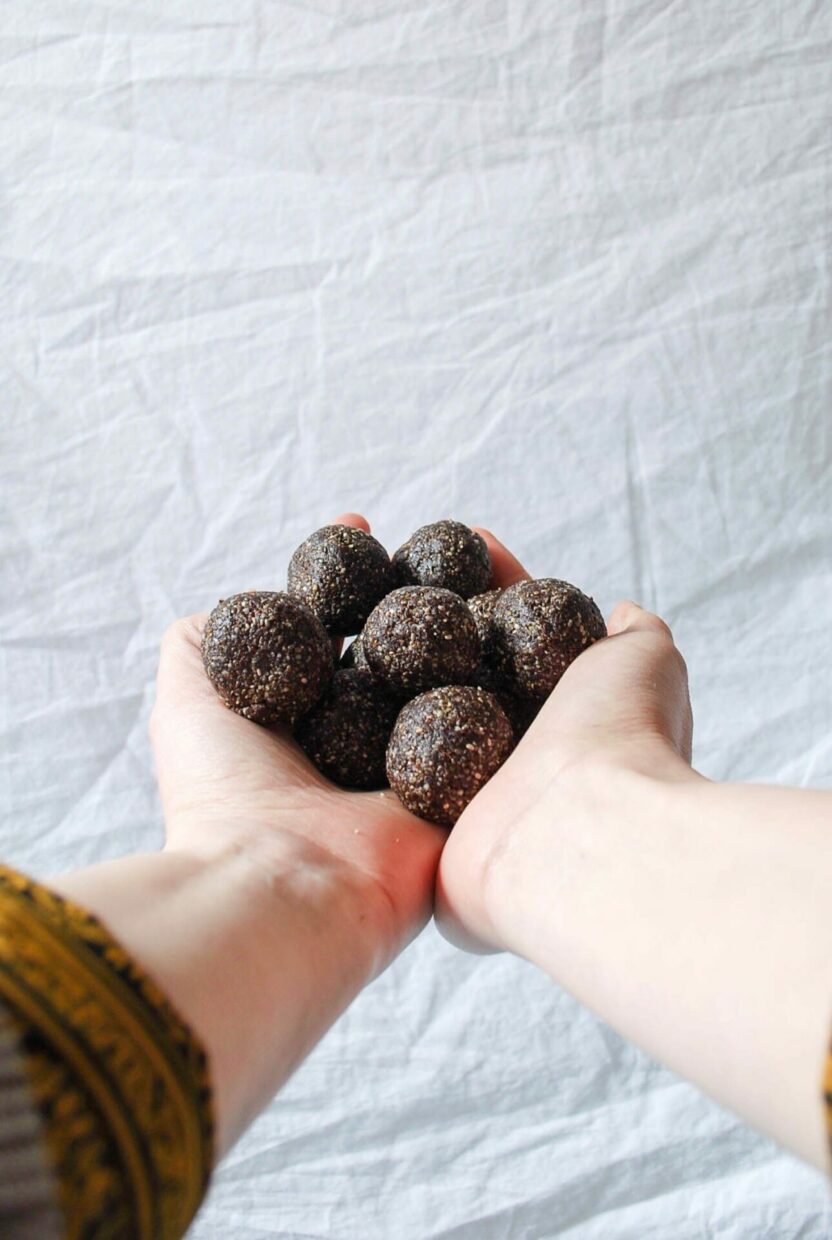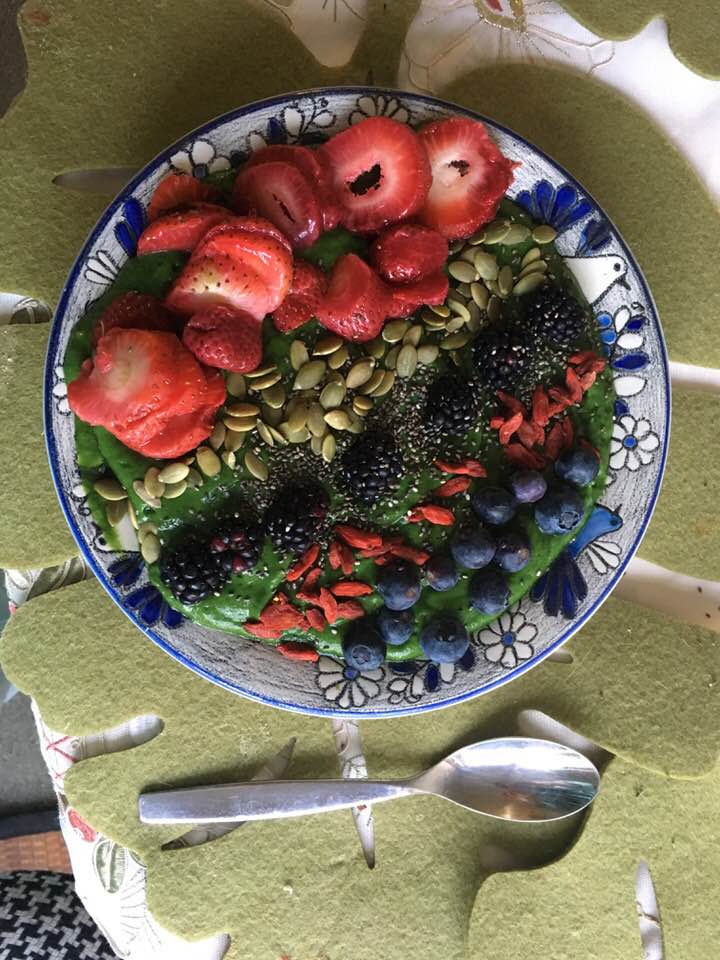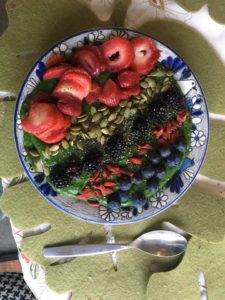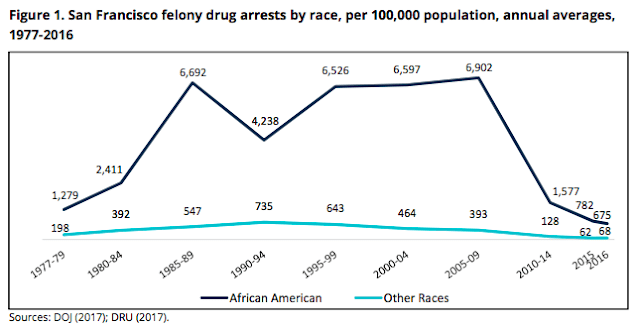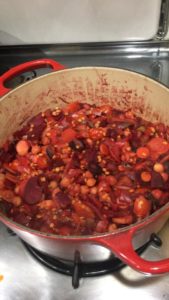Masala Superfood Balls
I had an action-packed morning and, on my way home, really wanted something sweet with my tea. But rather than stopping somewhere on the way for some empty calories, I remembered I now have all these fancy nuts and dried berries at home! So I spent five minutes concocting these little delicacies, which can be made bigger or smaller.
8 medjool dates
4 tbsp almond butter
2-3 tbsp maca powder
2-3 tbsp mixed nuts and berries (I had this one, which is very fancy, but you can vary)
1 tsp garam masala
Chop up dates and break big nuts into smaller pieces. Moisten your hands and mix everything together to a doughy, sticky consistency. Roll little balls and store in fridge until they harden a bit.
Green Goddess Bowl
Across the street from the baby store and community center Natural Resources, where Río and I go for classes and activities and to meet other new parents and babies, is a wonderful little gem of a cafe called Beloved. That place is magical. It’s as if someone came over and asked me, “Hadar, what do you like to eat?” wrote down everything I said, and made that the menu. Everything on offer is plant-based, whole-foods based, and as delicious as it is beautiful. Their juices and smoothies are a marvel, and they even have four versions of what is quickly turning into my favorite breakfast: The smoothie bowl (yes, I’ve enthusiastically joined the fad.)
The principle is rather simple–a thick smoothie, in a bowl, with exciting toppings. I think I’ve managed to recreate one of my favorite Beloved recipes, which I offer here for your enjoyment.
For the smoothie
1 pear
3/4 small avocado, or 1/2 a big one
2 cups raw spinach
1/2 small lemon or lime (with the peel!)
1 tsp spirulina
2 medjool dates, pitted
small chunk of ginger
1 cup coconut water
For the toppings
fruit, berries
dried berries and fruit (goji berries look pretty against the green, as do goldenberries)
seeds: hemp, flax, chia
granola or muesli
fancy nuts
Preparation is very easy: throw all ingredients into the blender and blend until smooth (the lemon can be blended with the peel!). Then, pour into a bowl, leaving some room at the top. Then, get creative with the toppings! You can do rows, circles, whatever you like. Then EAT!
CJCJ Study: Drug Arrests Plummet, Racial Disparities Persist
I got a lot of commentary, in person and on Facebook, after my post about Ban the Box backfiring. Folks were expressing serious frustration with how an idea that seemed so good–pushing people away from racial discrimination by proxy–turns out to do something spectacularly bad in the world–pushing people toward direct racial discrimination. Today’s post is along the same vein, but somewhat less depressing.
A new CJCJ study by Mike Males and William Armaline finds a spectacular decline in arrest rates for drug offenses in San Francisco. But when they broke the arrests down by race, this is the pattern that emerged:
Now, several things are notable. First, the decline is significant – even for African Americans. Which is arguably a very good thing for everyone. Second, while the racial disparity is still enormous–felony drug arrests for African Americans were ten times higher than those of people of other races–it is a significant decline from previous levels of disparity (the peak year for discrimination was 2008, when African Americans were 19.2 times more likely to be arrested for a felony drug offense than people of other races.) Finally, disparities typically shrink, rather than disappear overnight, so this could be a move in the right direction.
But this raises the question of how we measure progress. Are things better when there are overall arrests, even when large disparities (which are uncorrelated with other measures of involvement in these offenses) persist? What is the goal of relaxing drug policies?
Recently, the standard war-on-drugs-responsible-for-mass-incarceration story has been criticized, and it does seem to be a bad explanation for the overall picture. But the basic argument that drug arrests tend to target the African American population is not new. Amanda Geller and Jeffery Fagan have an excellent paper about marijuana arrests in NYC that tells a similar story. We really have to do better.
Reform and Unintended Consequences: The Case of Ban the Box
In early February, Malcolm Feeley won the President’s Award from Western Society of Criminology. It was a real treat to be able to recognize and reward, if only modestly, all he has been and done for me over the years with a mentorship award, and even more of a treat to hear him give a breakfast keynote titled The Failures of the Adversarial Process. In his talk, Malcolm revisited some of his arguments from Court Reform on Trial, and made the sobering observation that, where criminal justice reform is concerned, failure is the norm; it is the occasional success that should surprise us. Malcolm ascribes this to the structural/organizational context in which the reforms happen, and to the underpinnings of racism and hypercapitalism; according to him, the criminal process is in a constant state of market failure, and it’s only outside innovators that have to bail us out once in a while (seems like this is what this new PAC is trying to do.)
I was thinking about Malcolm’s wise words today, when I was invited to an event to support Ban the Box. As my regular readers probably recall, I’d been fighting for Ban the Box for a long time, until finding out in 2015, to my dismay, that it has had disastrous unintended consequences.
I was speaking at a conference in Sacramento when I ran into the good folks from the Urban Institute, whom no one would suspect of being cryptofascist double agents, and talked to them about this. When they mentioned the findings of this study I was beside myself with disillusionment and shock. Essentially, what they found is that, when criminal record information is unavailable to progressive employers, they tend to discriminate against young men of color–possibly because they see race as a proxy for criminal history (which, in itself, is sometimes used as a proxy for race. Sick, sad world.) In their words:
Research on ban the box has shown that it increases callback rates for people with criminal records (Agan and Starr 2016). Agan and Starr (2016) find that ban-the-box policies “effectively eliminate” the effect of having a criminal record on receiving a callback. Case studies from specific cities support these results, showing that hiring rates for people with criminal records increased after ban the box was implemented (Atkinson and Lockwood 2014; Berracasa et al. 2016). Additionally, ban the box as a social movement has drawn attention to the plight of people with criminal records and has increased awareness of the challenges they face beyond employment.
But recent research has concluded that ban the box also reduces the likelihood that employers call back or hire young black and Latino men (Agan and Starr 2016; Doleac and Hansen 2016). These findings suggest that when information about a person’s criminal history is not present, employers may make hiring decisions based on their perception of the likelihood that the applicant has a criminal history. Racism, harmful stereotypes, and disparities in contact with the justice system may heavily skew perceptions against young men of color.
Several other studies have found similar outcomes. So, I’m no longer on the Ban the Box bandwagon. But what should we do instead? The Urban Institute team runs us through some options and their pros and cons:
My grim conclusion, inspired by Malcolm’s talk, is that as long as we have the nexus race-crime so embedded in the conversation (read Khalil Gibran Muhammad’s book to figure out where this came from) nothing we try to devise to avoid discrimination will get rid of it entirely.
The Courage to Reach Out: Why Addressing Violent Criminals Is Better for All of Us
The classic approach toward violent crime that scares us has been to ratchet up sentencing. But draconian sentences do not function well as deterrents of crime. General deterrence is a function of three factors: the severity of the sentence, the certainty of getting caught, and the speed at which justice is administered. The Achilles’ heel of this trifecta is the certainty factor. It is often very difficult to get witnesses to come forward and testify against perpetrators of violent crime, and this is partly why a third of U.S. homicides remain unsolved. Often, the police and prosecution has some notion of the perpetrator’s identity, but not enough evidence to bring charges against him or her. Even the most aggressive prosecution or the most severe sentences won’t result in getting the person off the street, and certainly not of making us safer (though they will, and do, result in clogging our prisons.) And of course, the goal is not (or should not be) putting people behind bars for incarceration’s sake. We all benefit so much more if we prevent homicides from happening in the first place.
Which is why the City of Sacramento is ready to try something new. Following the example of the City of Richmond, Sacramento is investing in a new initiative, known as Advance Peace.
Advance Peace focuses specifically on gun violence, and on the evidence-backed premise that, typically, a small number of perpetrators are responsible for a considerable percentage of the gun violence in a city. This is true for both Richmond and Sacramento: in the latter, the police estimate that there are fifty easily identified people who commit most gun crimes in the city–even though there isn’t necessarily evidence against them that would stick in court. The program consists of personalized, early intervention with these particular individuals, providing them with mentoring and opportunity, and diverting them away from gun violence. In the program’s words:
Advance Peace interrupts gun violence in American urban neighborhoods by providing transformational opportunities to young men involved in lethal firearm offenses and placing them in a high-touch, personalized fellowship.
By working with and supporting a targeted group of individuals at the core of gun hostilities, Advance Peace bridges the gap between anti-violence programming and a hard-to-reach population at the center of violence in urban areas, thus breaking the cycle of gun hostilities and altering the trajectory of these men’s lives.
Advance Peace works with both public and community-based stakeholders to establish responsive community-driven strategies that achieve high-impact outcomes for those caught in the cycle of urban gun violence.
The Richmond program, which has been in place since 2010, has been a success. Between 2010 and 2016, homicides in Richmond fell 60% (77% according to NPR, but there’s been a little uptick in 2017). This is more than twice–and almost thrice–the decline that other cities have seen. In addition, out of the 84 fellows who started the program in 2010, 94% are alive, 83% have had no gun injuries or hospitalization, and 77% have not been suspected of any gun activity. This is remarkable given the program’s focus specifically on people who were active participants in the gun violence scene in the city.
Sacramento is hoping to see the same benefits, but the program is not without its detractors. As usual, the objection is not scientific but moral/political: the program involves stipends to the perpetrators, and “rewarding bad boys” is a controversial move when the money could be used to reward “good boys.”
Municipalities always operate in an environment of limited resources. Giving money to suspected gun criminals takes it away from education, infrastructure, and health care, which feels understandably unfair. But when allocating money, “what’s fair” should not be the only, or perhaps even the dominant consideration. Where would the money spent on this program make us safer?
To answer this, we need to widen our perspective to understand a debate raging in the last few years about the causes of incarceration. The story we have told ourselves for decades–I’m guilty of this as well–places the blame for mass incarceration on the racialized war on drugs. According to this story, popularized by Michelle Alexander to the point that it’s difficult to argue with laypeople about it, Nixon and Reagan targeted people of color, incarcerating them for nonviolent offenses for unconscionably long periods of time, leading to the explosion of prison population and especially to its racial distribution.
But recently, John Pfaff has drawn our attention to the fact that the bulk of incarcerated people in America are doing time for violent crime. Adam Gopnik summarizes Pfaff’s argument as follows:
During the great wave of incarceration—generally thought to have begun around 1980, and cresting about three decades later—state prisons added something like a million inmates, with about “half that growth coming from locking up more people convicted of violence,” Pfaff calculates. Nonviolent drug offenses accounted for only around a fifth of the new incarcerations.
What’s more, many of the drug convictions were meant to be what Pfaff calls “pretextual attacks on violence.” Violent crimes that are associated with drug dealing are more difficult to prosecute than drug offenses themselves, which usually involve hard evidence rather than the testimony of witnesses. This argument sets off some suspicious-skeptical alarms, since it seems cousin to the idea that we might as well lock ’em up for drugs as for anything else, since, if we didn’t, “they” would be committing violent offenses anyway. “It is, of course, completely fair to debate the morality . . . of using drug charges to tackle underlying violence,” Pfaff observes, to his credit. He accepts that “blacks are systematically denied access to the more successful paths to economic stability,” and therefore “face systematically greater pressure to turn to other alternatives.” But he also makes a more complicated argument, following recent sociological research: it’s not that the prohibition of drugs attracts crime, which then produces violence; it’s that violence thrives among young men deprived of a faith in their own upward mobility, making drug dealing an attractive business. In plain English, young men without a way out of poverty turn to gangs, and gangs always turn to violence. Since efficient drug dealing is, by its illicit nature, likely to involve violence, those accustomed to violence are drawn to drug dealing. One sees the logic: Lucky Luciano and Al Capone weren’t ambitious street kids who chose bootlegging as a business, and were then compelled to become gangsters to pursue it, as in “Boardwalk Empire.” They were already cadet gangsters, who saw that their acquired skills lined up neatly with those demanded by bootlegging.
Pfaff’s conclusion from the data is that the responsibility for mass incarceration lies primarily with county prosecutors. The answer should, according to him, be a more parsimonious prosecutorial policy, avoiding overcharging even in violent offenses, which are, after all, not made of the same cloth. But what if instead of modifying prosecutorial policies after bad things happen we were to try and remedy the problem of lack of alternatives before the violence occurs?
This is exactly the rationale of programs like Advance Peace. By providing people who are at the very heart of violent behavior an opportunity to exit the violent world, we could provide more safety to more people, and at the same time target incarceration where it really matters.
To go down this path, we have to be courageous enough to understand that, ultimately, the city of Sacramento stands to benefit so much more from a reduction of violence–both in terms of preventing the violent incidents in the first place and in terms of reducing the costs of clogging the system with efforts to prosecute the targeted folks–than it would from the business-as-usual lock-’em-up policy. People who commit violent offenses are often caught for low-level drug offenses, and they will eventually leave prison more violent and less conducive to interventions than when they came in, and even if they are caught for homicide and placed in prison, we will all have to keep up the tab. If people do not commit crime to begin with, we all win. This may not be “fair”–to the extent that offering people opportunities that they’ve been deprived of their whole lives, pushing them to violence, is “unfair”–but it turns out to work better than the alternative.
I’m excited and happy to partner with the City of Sacramento to offer an expanded, data-rich version of this argument as a keynote speaker in their upcoming violence reduction summit. I hope to see many of you there.
He’s-Finally-Asleep Nonalcoholic Cooler
Juice from 1 tangerine
1/2 cup cranberry juice
2 cups water
2 Persian cucumbers or 1 English cucumber
mint leaves to taste
maple syrup to taste
cucumber slice for garnish
Moroccan Red Stew
This was absolutely delicious, and the reason there was no picture the first time I made this is that it was gobbled up before I had the chance! Good thing I remembered to take a picture the second time. It comes out a very vivid and appetizing shade of red, because of the tomatoes and the beets, and can be served over mashed potatoes, rice, couscous, or quinoa.
Ingredients:
1 large red onion, thinly sliced
2 leeks (just the white parts), thinly sliced
7-8 garlic cloves
splash of vodka
1 cup vegetable broth
1 little basket of cherry tomatoes
1 carrot, sliced into thin rounds
1 beet, chopped and thinly sliced
3/4 cup yellow lentils, dry
1 cup chickpeas, cooked
2 tsp cumin
2 tsp baharat
2 tsp ras-el-hanout
salt and pepper to taste
Preparation:
Heat up a Dutch oven on the stove until a drop of water at the center looks like mercury. Then, add onion and leeks and cook until the bottom of the pan begins to brown and the onions are translucent and a bit golden. Add a splash of vodka to deglaze the bottom, add the garlic, and cook for another 30 seconds. Add broth, tomatoes, carrot, beet, lentils, chickpeas, and spices. Place lid on Dutch oven and cook for about 25 minutes, or until the dish is fragrant and the lentils are soft.



